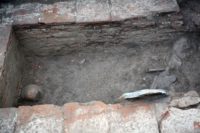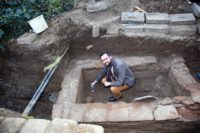 On March 29th, a Roman tomb was discovered on the campus of the Medical University of Plovdiv in Bulgaria. Workers stumbled on the find while doing repairs to the steam system in the courtyard behind the Rector’s office. Archaeologists were immediately called in to excavate the tomb. The University of Plovdiv’s Zdravka Korkutova and Medical University of Plovdiv Associate Professor Georgi Tomov found a fully intact tomb in exceptional condition containing inhumed skeletal remains.
On March 29th, a Roman tomb was discovered on the campus of the Medical University of Plovdiv in Bulgaria. Workers stumbled on the find while doing repairs to the steam system in the courtyard behind the Rector’s office. Archaeologists were immediately called in to excavate the tomb. The University of Plovdiv’s Zdravka Korkutova and Medical University of Plovdiv Associate Professor Georgi Tomov found a fully intact tomb in exceptional condition containing inhumed skeletal remains.
The tomb is a single chamber made of brick and mortar covered by a granite block. Within just a few hours’ work, the archaeologists unearthed parts of a skull and lower leg bones.
Prof. Tomov said: “Probably the tomb is from the second to the third century and more than one person was buried there, that is, it is a family tomb. This will become apparent after an anthropological study of what is there has been done. By examining the skeletons, we will get information about the gender and age of the buried, their health, whether they have suffered from illness, and what kind of medical interventions they have had.”
The date estimate is derived from the style of the tomb and its location. In the Roman period, Plovdiv, then known as Philipopolis, had four necropolises just outside the city boundaries, as was customary in Roman urban planning. The largest of them was opened in the 1st century A.D. just to the west of the city and as Philipopolis prospered in the 2nd and 3rd centuries, the cemetery expanded westward towards the hill of Dzhendem tepe. (Plovdiv has seven hills too, btw.) It had been the site of religious shrines since the Bronze Age, and the Romans built the city’s main temple dedicated to Apollo Cendrisseos there, so it was religiously fitting that a necropolis would reach its foothills. The campus of MU-Plovdiv is in the shadow of Dzhendem tepe.
 The tombs built for people of means during this time of expansion and prosperity are of markedly higher construction quality than the ones before or after. They are made of brick and mortar with plum and flush walls, like the one just discovered behind the Rector’s office. When the city’s fortunes began to decline in the 4th century, the tombs were more patchwork affairs, modest in scale and constructed from recycled building materials scavenged from earlier structures.
The tombs built for people of means during this time of expansion and prosperity are of markedly higher construction quality than the ones before or after. They are made of brick and mortar with plum and flush walls, like the one just discovered behind the Rector’s office. When the city’s fortunes began to decline in the 4th century, the tombs were more patchwork affairs, modest in scale and constructed from recycled building materials scavenged from earlier structures.
The skeletal remains are currently being studied. MU-Plovdiv’s rector, Dr. Stefan Kostyanev, behind whose office the tomb was found, hopes the finds can eventually be displayed in yet-to-be-built University museum.
Maybe the ghostly family will rise up and haunt the rectors… 😉
You’ve spelled Plovdiv as Plovdid four (or more?) times here. You may wish to fix (Don’t want you to upset your Bulgarian readers!).